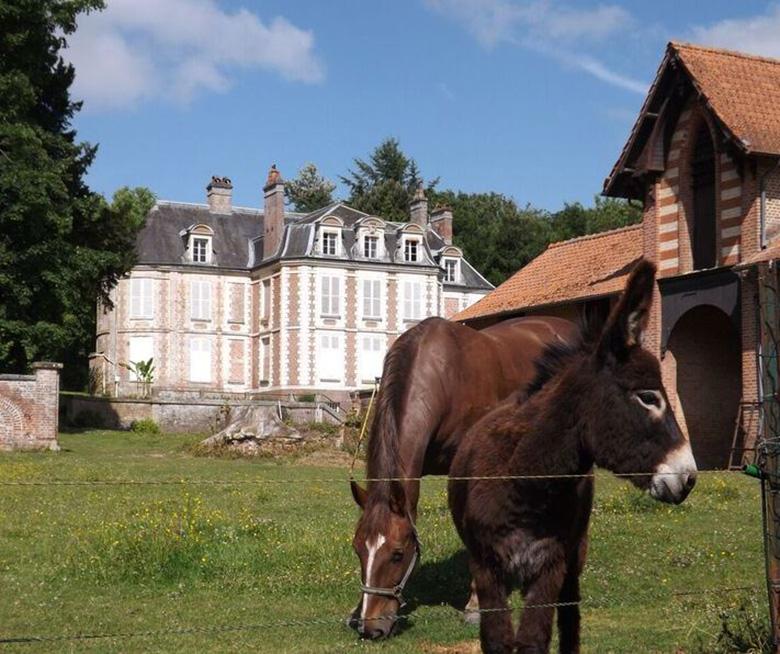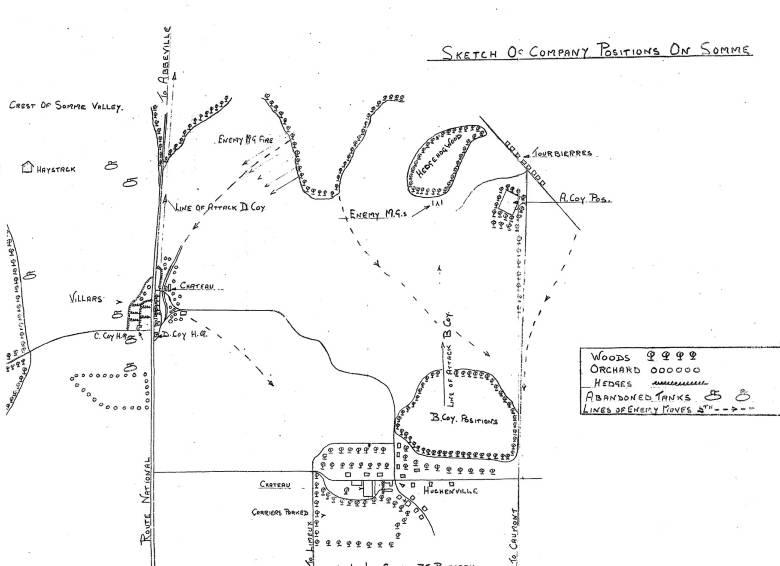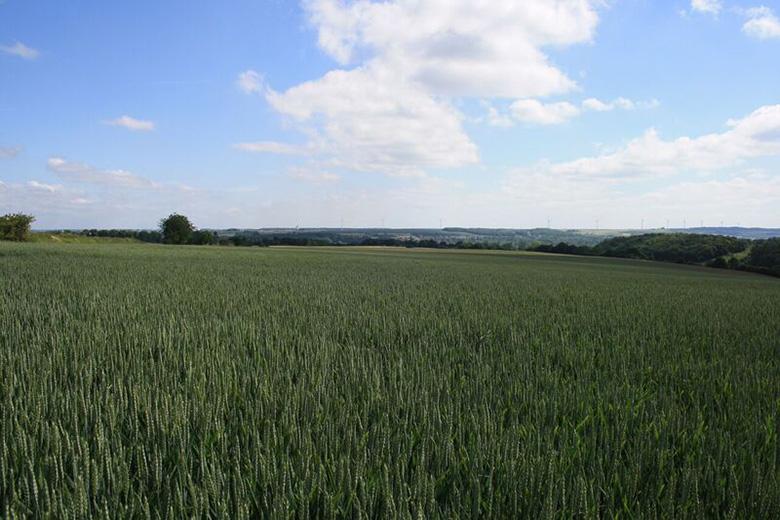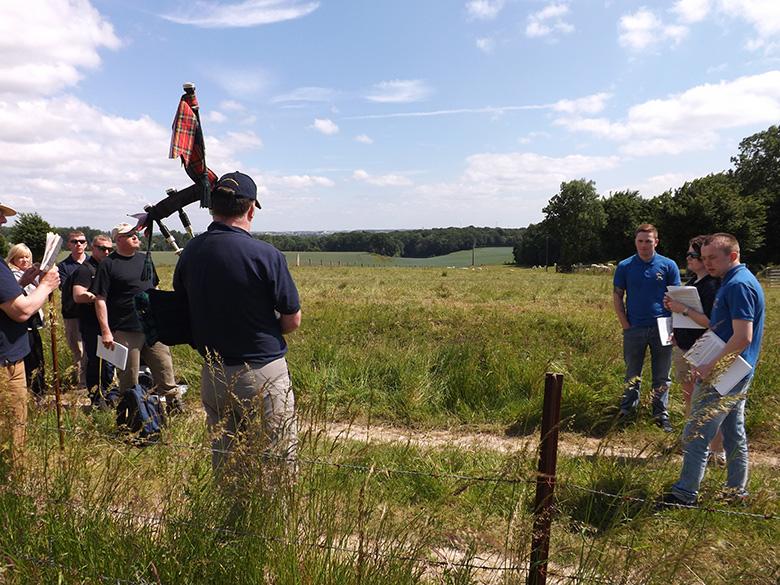4th Camerons Attack at Huchenneville
04 June 1940
Much of what follows has been extracted from 'Churchill's Sacrifice of the Highland Division' by Saul David. I am indebted to him for giving me permission to quote verbatim from his book. For those wishing to follow the movements and actions of the Division there is no better handbook to guide the visitor through the various actions of the Division on the withdrawal to St.Valery.
Brig. Charles Grant
Site Historian.
4th Camerons Attack at Huchenneville
04 JUNE 1940
"Supported by the guns of the 1st Royal Horse Artillery, the 23rd Field Regiment and the 215th Medium Battery, the battalion's mission was to take the village of Mareuil-sur-Somme, and from there to prevent any enemy attempts to cross the river to reinforce the bridgehead. Prior to the attack, the 4th Camerons were deployed with: Battalion Headquarters in the Chateau de Huchenneville;

Chateau de Huchenneville
show infoDescription:
Photo of the Chateau at Huchenneville, taken in 2015.
Tags:
A Company was some way forward to the right, on the high ground immediately behind the hamlet of Tourbieres; B Company was between these two positions in a wood in front of Huchenneville; C and D Companies, and a platoon of 152 Brigade Anti-tank Company, were holding the village of Villers, about a mile to the north of Huchenneville and strategically positioned on the Route Nationale.
It was decided that the assault would be pressed on a two company front: B Company would move forward and take the strongly-held Hedgehog Wood, to the left of A Company's posts which would provide covering fire. D Company would follow a quarter of an hour later, parallel to the Route Nationale, and capture the crossroads at Mareuil. C Company's role would be to thin out its defences and take over D Company's vacated positions. Yet, because of the loss of one of D Company's platoons to shell and mortar fire the day before, 14 Platoon of C Company under Second Lieutenant Johnston would accompany D Company leaving only two platoons to defend Villers.

4th Camerons Attack at Huchenneville Sketch Map
show infoDescription:
Sketch map showing the line of attack and positions of 4th Cameron Coys. during the attack at Huchenneville on 4th June 1940. A version of this original sketch is recreated within "Churchill's Sacrifice". This original sketch is in a manuscript account in an exercise book written in a prisoner of war camp. The book does not say who the author was but there is a loose letter in it to Major W A Macleay, 4th Battalion Q.O. Cameron Highlanders, commending a L/Cpl for his actions on the Somme on 4/5th June and it is assumed that Major Macleay was the author of the diary and map.
High Resolution Image:
Tags:
B Company Attack on Hedgehog Wood
At Zero hour, B Company, made up of men largely from the islands of Harris and Kye, moved off towards Hedgehog Wood, aptly named as its defences were bristling with machine-guns and rifles. Leading was Second Lieutenant Clark's platoon on the right, Second Lieutenant Robertson's on the left, with Captain The Viscount Fincastle, B Company Commander, following up with his headquarters and the last platoon under Second Lieutenant Spiers. The company moved in extended order, 126 men strong, across a broad expanse of flat ground with little cover.

"B" Coy. Huchenneville
show infoDescription:
View from starting line of attach by "B" Coy. 4th Camerons from Huchenneville towards Hedgehog Wood, 4th June 1940
Tags:
There were no ditches and only a few shallow depressions in which to hide from the bullets and shrapnel that were about to consume them. Confidence had already been dealt a blow by the inaccuracy of three French planes which, a few minutes earlier, had bombed the company positions by mistake. This misfortune was compound when the barrage that was aimed at the front edge of the Hedgehog fell short, leaving its defenders unscathed and ready to reap destruction. The left hand man of the left hand unit, 12 Platoon, was Private Sandy Russell, the former battle patrol member:
"The whistles sounded and we were on our way. When we left the trenches and looked towards Hedgehog Ridge all was smoke and fumes, and aerial and ground explosions. The enemy was supposed to be no nearer than that ridge and it came as an unpleasant surprise when we came under intense machine-gun and mortar fire after having gone only about 100 yards. On my left was a large field of waist to shoulder high wheat, and I was tempted to go into it for some cover. However, when I saw large swathes being cut in it by opposing fire I decided to carry on where I was.
The racket was hellish with Jerry mortars falling in all directions and men spinning and falling or being blown up. I saw my old friend from schoolboy days hit by a burst from a machine-gun, followed by Neil Mackenzie and several others being hit in succession. I came to a small hole and from it chucked two or three grenades in the general direction of the Jerry machine-gun. I think I might have stayed there all day, but Lieutenant Robertson came along shouting, 'Come on, come on we can't stay here!' I followed him quite closely until we came to a hedge about half a mile from our objective. He called on us to dig in but already there was a line of slit trenches and a small orchard. I, along with Robertson, was furthest on ...
I fired two shots out of my rifle when suddenly, there was an almighty red flash and a bang and I found myself sitting in the bottom of the trench on top of some guy who was semi-conscious. Another mortar landed on top of the trench area about one and a half yards away and blew a heap of earth on top of me. The Jerries seemed to have this hedge well ranged because, for the next 20 minutes, it became a living hell. When the barrage eased off, we got the order to join A Company at the far end of the orchard about 200 yards further back."
The order had come from the company commander, Lord Fincastle, who with the remnants of the company had arrived in that area. Amazingly, at this point only one man of Russell's section was a casualty and that was by friendly fire in the heat of battle; every man in the remaining two sections - around 20 men - of 12 Platoon had been killed or wounded, other than Second Lieutenant Robertson. Despite the failure of the barrage, that fell short a second time, Robertson and Russell had reached the foremost point of B Company's advance and had forced at least one machine-gun post to withdraw.
Moving up in the centre with B Company Headquarters was Company Quartermaster Sergeant Gregor Macdonald:
"By the time we were half-way to the objective we had seen a number of our men go down - if the casualties were close at hand one tried to help, but our objective was first priority and we were forced to leave many where they fell. Then, quite suddenly, there appeared before us what must have been at least two enemy companies who had been lying unseen in the rye crop and only appeared when we were within 100 yards. They greeted us with a hail of fire from their Spandau machine-guns and huge gaps appeared in our formations. By this time we were getting near our objective and, with a final desperate effort, we reached the edge of the escarpment bordering the River Somme. In the confusion of battle, we had veered slightly to our right and found ourselves very close to our A Company position ... The last 100 yards had cost B Company dearly and at roll call only 41 men stood up. Of the officers, only Captain Fincastle and Second Lieutenant Robertson survived the advance ... , while two sergeants were killed and three wounded, leaving the Sergeant Major and I as the only surviving senior ranks."
There were now two pressing problems for the survivors to face: defence against counter-attack and evacuation of the many wounded. The first was 'solved' by pushing forward 12 men to defend the front of the orchard, while Company Quartermaster Sergeant Gregor Macdonald and the Company Sergeant Major - also named Macdonald and known to his men as 'The Muc', or pig, in Gaelic because of his reputation as a hard disciplinarian - began to gather the wounded together. During his rounds the 'Muc' noticed that Captain Fincastle had been hit in both legs by machine-gun bullets, and he hurried over to dress them. Seeing Company Quartermaster Sergeant Macdonald nearby, he shouted for help.
"I made my way to where the Company Commander lay, and was cutting the stitching on my battle dress pocket where the first field dressing was carried when the mortar battery again concentrated on our position. Unlike artillery fire, the mortars give no warning and my first recollection was being thrown to the ground by the blast and trying to regain my feet. The Sergeant Major, his face covered by blood, shouted 'QMS give me a hand - I think the Company Commander has had it'. I moved across to where Captain Fincastle lay to find that the last mortar had landed on him and he was already dead. I hurriedly put a plaster on the Sergeant Major's own wound but he assured me it was not serious. At that moment, another mortar landed between us and I felt a burning sensation in my head. When I retrieved my helmet, I found that a piece of shrapnel had gone in below the rim and out through the crown, leaving me with an uncomfortable head wound ... By this time, a number of the men wounded in the final assault had crawled into the orchard, while others were being carried in by their comrades. We used the ammunition truck to take these men to the Regimental Aid Post, packing in 20 wounded."
Before leaving Fincastle, the 'Muc' retrieved his personal effects. He could not help looking at his pocket book in which there was a family 'snap' of Fincastle, Lady Fincastle and their little boy, who was just two years old. Faced with this, tears started rolling down the cheeks of the Sergeant Major who, it was said, would have put his own grandmother on a charge.
In the afternoon, after a hazardous trek, the company cooks managed to reach the survivors of B Company with enough food for 130 men. They found less than 40. But Sandy Russell was famished and, because there was so much extra food, he remembers the meal of bacon and bread as the best feed he had had in the Army, even though it was rudely interrupted by another mortar barrage, causing three more casualties. Following this happy diversion, Russell was brought back down to earth by the unenviable task of gathering the corpses.
"We started to assemble the dead and it was a harassing duty to see all our good friends lying there in such a grotesque look of death. Our company commander was amongst the slain and he was well-loved and respected. Lieutenant Robertson departed for Battalion Headquarters to make his report and the rest of us came under the leadership of CSM Macdonald. He was here, there and everywhere encouraging us, showing us where he wanted slit trenches dug and generally keeping us busy to ensure discipline would not slacken."
It was lucky that the attack was not resumed from A Company's positions because the Germans had anticipated this, and had vacated the front edge of the Hedgehog to allow it to be bombed by their Stukas. Eventually orders came for the 'Muc' to leave a party of 13 to assist A Company - Sandy Russell was amongst them - and to withdraw after dark with the remaining 26 men to their original positions in the wood in front of Huchenneville. There they were met by D Company of the 5th Gordons who had been rushed across in the evening to stiffen the 4th Camerons, now so seriously depleted after their heavy casualties.
D Company Attack along the Route Nationale
The second part of the two-pronged attack by the 4th Camerons, undertaken by D Company, was planned to start at Zero plus 15 minutes to allow B Company time to neutralise the Hedgehog Wood. This never happened and, during the advance, D Company was machine-gunned from both the front and the flank.
While forming up, D Company had suffered another misfortune to add to the loss of one of its platoons the previous day: The commander of the leading platoon, Platoon Sergeant Major Noble, was killed by shellfire. His place was taken by the Company Second-in-Command, Captain Burton. Second Lieutenant Macdonald was to follow with his platoon on the left, and Major Threlfall, the company commander, would bring up the rear with his headquarters and Second Lieutenant Johnston's platoon from C Company.

"D" Coy. Position, Huchenneville
show infoDescription:
Photo take during a Battlefield Tour in 2015 showing the view from the start line for 4th Cameron's D Company attack on 4th June 1940. The "Route National" is off to the left. The enemy position was in the bulge in the wood on the horizon.
Tags:
As the forward platoon moved off, Second Lieutenant Macleod, commanding the 152 Brigade Anti-tank Platoon in Villers, arrived on the Start Line - between the Route Nationale and the Chateau de Villers - with some more, unwilling, participants. These 18 sheepish-looking soldiers were the reinforcements who had arrived the day before and who had been overlooked in the preparations for the attack; Macleod had found them fast asleep in their farmhouse billets. It would not be long before they wished they were back there.
Watching the troops move off was Private Alexander Grant of the 3-inch Mortar Platoon, positioned in a sunken road near to the Start Line. He and his comrades were waiting for the forward troops to take a clump of trees directly ahead at the top of a wheat field, which would be the signal for them to rush up in support:
"We heard a whistle blow, then the bagpipes and soon after we saw Piper Mackay coming out leading the advancing troops of D Company; the Germans waited until they were 50 yards up and then opened up with their spandaus from this group of trees to the front. The piper went down and soon after Major Threlfall was hit, He was a big man, very tough, but a lot of people say he had a bottle of gin inside him that morning. We couldn't believe our eyes, it was suicide. Men were going down like flies, falling all over the place. What sheer madness, they went forward without a tank, without anything."
Major Threlfall was seen to rise after he was hit, and then fall once more close to the Route Nationale, up the right of which the company was advancing. He was dead. Second Lieutenant Ian Macdonald was hit in the bullet-swept orchard beyond the hedge marking the Start Line but was later evacuated to safety. He later spoke of being fired on by a number of tanks and it is almost certain that these were the French tanks in the 4th Seaforths sector who mistook the Camerons for Germans. Second Lieutenant Johnston was also hit soon after starting and lay out in the open all day until, like Lieutenant Macrae of the 4th Seaforths, under cover of darkness he crawled back to safety. The most progress was made by Captain Burton and the remains of his platoon on the right, but soon they too were pinned down. Burton, like Threlfall was seen to fall as if hit and he was later reported as presumed killed. But he was a hardy fellow and later made it back to the British lines. Out of the whole company, only a handful had made it past the scanty cover of the orchard in front of the Start Line, and into the wheat field beyond.
The enemy machine-gun, mortar and shell fire had grown in intensity as the attack progressed, and there was little hope of hitting back because of the inadequacy of the artillery observation. In any case, the artillery had largely missed its front line targets and was now following a prearranged timetable of bombardment against targets beyond. All the while the wounded were making their way back to Villers and at 9 am Company Sergeant Major Simmons arrived at the old company headquarters, which had since been taken over by C Company. He had with him the remnants of the company, about 50 men, including a number of the 4th Seaforths who had strayed across from the other side of the Route Nationale.
At 9.45 am Company Sergeant Major Simmons returned from C Company Headquarters at the bottom of the village and placed himself under Second Lieutenant David Ross of C Company who, with his platoon, was holding a position to the right of the Route Nationale near the Start Line. After receiving an instruction from his company commander, Captain Ross (no relation), to act at his own discretion, Ross decided to form the returned D Company and 4th Seaforths men into two groups - one under Company Sergeant Major Simmons and one under Sergeant Macleod - to resume the attack. The results were tragic and inevitable: after advancing just 200 yards to the front of the orchard the attack was halted by murderous machine-gun fire from the wood off to the right and the survivors finally crawled back in under the cover of a shallow ditch.
After this Second Lieutenant Ross liaised with Captain Pelham-Burn, the commander of D Company of the 4th Seaforths dug in across the main road, and together they organised parties to collect the wounded and carry them back to the chateau.
Later in the day, after a visit by the battalion Second in Command, Major Stanley Hill, a platoon of 7th Norfolks pioneers was sent up to strengthen the position. They were joined by 12 other Camerons under Second Lieutenant Slater, a reinforcement officer, and used to strengthen the position to the right of the chateau which was already being held by Lance Corporal Walsh and 17 men who had survived the two attacks. The Norfolks protested strongly that as pioneers they were not equipped to be used as front line troops, but every man was needed and their protests were ignored.
The remaining hours of daylight on 04 June were used by C and D Companies to continue to evacuate the wounded. The RAMC had prohibited the use of ambulances in front of Huchenneville, and so this was carried out by the anti-tank lorry and the ration truck when it came up. There was no news of a relief.
152 Brigade's casualties on 4June were a crippling 20 officers and 543 other ranks, the major proportion being borne by the 4th Seaforths and 4th Camerons. In effect, these two battalions were now down to 50 per cent of their fighting strengths.
Division History References :
The 51st Highland Division landed in Le Havre in January 1940 as part of the British Expeditionary Force [B.E.F.] On 28th March they were deployed into the defensive line relieving the French 21st Division between Bailleul and Armentiéres...
